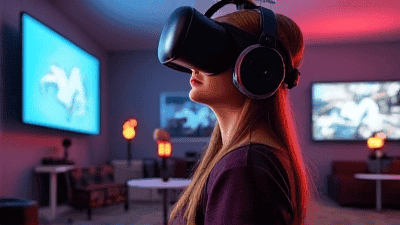
Fear's Embrace: Decoding the Surprising Psychological Architecture of Horror Films in the Brain
Horror films, a popular genre known for eliciting intense fear and suspense, represent more than mere entertainment. They engage the human brain in complex ways, triggering profound physiological and psychological responses that extend far beyond the fleeting moments of on-screen terror. What appears as a simple act of leisure viewing often initiates a cascade of intricate neural mechanisms, from primal fight-or-flight reactions to sophisticated cognitive processing, shaping our emotional landscape in unexpected ways.
The allure and impact of horror films have captivated audiences and intrigued researchers for decades, making them a significant area of study for the scientific community, particularly in neuroscience and psychology. These films offer a unique, controlled environment to explore the brain's responses to perceived threat, emotional regulation, and even the processing of moral dilemmas. Current developments in neuroimaging techniques, such as fMRI, allow scientists to observe brain activity in real-time, revealing how areas like the amygdala, prefrontal cortex, and hippocampus are engaged. This research is crucial for understanding general anxiety disorders, trauma responses, and the mechanisms of coping. What impact would it have on our understanding or practice of mental health if we failed to fully comprehend the intricate interplay between fictional fear and our genuine psychological architecture?
The Primal Scream: Neurobiological Responses to On-Screen Terror

Amygdala Activation and the Fight-or-Flight System
The immediate, visceral reaction to a horror film is largely orchestrated by the amygdala, a pair of almond-shaped nuclei deep within the brain's temporal lobes, recognized as the brain's "fear center." Upon perceiving a sudden threat or suspenseful scenario on screen, the amygdala rapidly processes these visual and auditory stimuli, triggering an instantaneous response before conscious thought fully engages. This rapid activation signals the hypothalamus, which then initiates the body's sympathetic nervous system, commonly known as the "fight-or-flight" response.
This cascade involves the release of stress hormones like adrenaline (epinephrine) and cortisol from the adrenal glands. Adrenaline causes a surge in heart rate, elevates blood pressure, quickens respiration, and diverts blood flow to muscles, preparing the body for immediate action. Concurrently, neurotransmitters such as norepinephrine are released, heightening alertness and attention. A sudden "jump scare," for instance, exploits this mechanism perfectly: a quiet scene is abruptly punctuated by a loud noise or startling image, causing an involuntary gasp or recoil as the amygdala sends urgent alarm signals throughout the brain and body. It's akin to an internal fire alarm, blaring at the first sign of smoke, regardless of whether the threat is real or imagined. This physiological arousal, paradoxically, can be perceived as thrilling by many viewers.
Beyond the Credits: Long-Term Psychological Reverberations
Desensitization, Catharsis, and Coping Mechanisms
Beyond the immediate physiological thrill, repeated exposure to horror films can instigate more enduring psychological shifts, primarily through processes like desensitization and catharsis. Desensitization, or habituation, occurs when an individual's emotional response to a repeated stimulus gradually diminishes. For frequent horror viewers, constant exposure to violence, gore, or frightening scenarios may lead to a reduced emotional reactivity over time. For example, a scene that might deeply disturb a novice viewer could elicit only a mild reaction from a seasoned horror fan, as their brain has learned to normalize the simulated threat. This reduction in emotional intensity isn't necessarily negative; it can be a protective mechanism, allowing individuals to process disturbing content without being overwhelmed.
Conversely, horror films can provide a unique avenue for catharsis – the psychological release of strong emotions. By experiencing fear, anxiety, or sadness within the safe confines of a movie theater or living room, viewers can process and purge these feelings without facing actual danger. This can be therapeutic, offering a sense of mastery over fear or an emotional "reset." Individual differences in personality, such as sensation-seeking traits, often dictate whether desensitization leads to apathy or whether catharsis offers emotional relief. For instance, high sensation-seekers may actively pursue horror for the thrill and emotional release it provides. After watching, individuals employ various coping mechanisms, from cognitive reappraisal (reminding oneself it's not real) to seeking comfort or distraction, highlighting the brain's robust ability to regulate emotional states post-experience.
Analyzing these long-term effects requires considering various individual factors. The table below illustrates how different psychological impacts manifest over time, varying by individual responses.
| Psychological Impact | Short-Term Effect | Long-Term Effect |
|---|---|---|
| Anxiety Levels | Elevated, often immediate post-film | Variable; can lead to desensitization or, for vulnerable individuals, increased generalized anxiety |
| Stress Resilience | Can temporarily decrease, then potentially strengthen via controlled fear exposure | May improve through repeated safe exposure to stressors, enhancing coping skills |
| Sensation Seeking | Satisfied by intense stimuli, leading to heightened engagement | Potentially reinforced, encouraging further pursuit of thrilling experiences |
This data suggests that while horror films can temporarily elevate anxiety, the long-term outcomes are highly individualized, ranging from enhanced resilience to potential amplification of pre-existing vulnerabilities. The brain's adaptability plays a crucial role in these varied responses, demonstrating a complex interplay between exposure, personality, and coping strategies.
The Mind's Labyrinth: Cognitive Engagement with Fictional Fear

Suspension of Disbelief and Emotional Regulation
Crucially, the enjoyment of horror films hinges on a fascinating cognitive tightrope walk: the suspension of disbelief. This is the voluntary setting aside of critical faculties and logical judgment to immerse oneself in a fictional narrative, even when that narrative presents impossible or highly improbable scenarios. Our brains are remarkably adept at distinguishing between real and fictional threats. While the amygdala might trigger an initial physiological alarm, the prefrontal cortex – the brain's executive control center – quickly intervenes. It recognizes the artificiality of the situation, dampening the primal fear response and preventing us from genuinely believing a chainsaw-wielding maniac is lurking behind the sofa. This conscious understanding allows us to experience fear as an enjoyable emotion, rather than a debilitating one.
Furthermore, emotional regulation strategies are constantly at play. Viewers consciously or unconsciously manage their emotional experiences, perhaps by reminding themselves it's "just a movie," covering their eyes during particularly gruesome scenes, or engaging in reassuring social interactions if watching with others. This interplay between the primal fear system and higher cognitive functions explains the "paradox of fear" – why we derive pleasure from something inherently aversive. The initial surge of adrenaline and cortisol, once regulated by the prefrontal cortex, can be followed by a release of endorphins and dopamine, the brain's natural feel-good chemicals. It's this complex dance between terror and relief, threat and safety, that contributes to the unique psychological appeal and long-term impact of horror films.
Conclusion
The psychological impact of horror films on the brain is a multifaceted phenomenon, extending far beyond the superficial scares. We have explored how the immediate neurobiological response, primarily driven by amygdala activation and the fight-or-flight system, plunges viewers into a state of heightened physiological arousal. Following this initial shock, the long-term psychological reverberations come into play, encompassing desensitization to frightening stimuli for some, and a cathartic emotional release for others. Crucially, the mind’s ability to engage with fictional threats through the suspension of disbelief and sophisticated emotional regulation mechanisms allows individuals to process and even derive pleasure from these intense experiences. Understanding these intricate interactions provides invaluable insights into human emotional processing, stress responses, and the dynamic interplay between entertainment and our core psychological functions. The horror genre thus serves as a powerful, albeit simulated, laboratory for exploring the human condition.
Looking ahead, the study of horror's psychological impact is poised for significant advancements, driven by new technologies and interdisciplinary collaboration. Emerging neuroimaging techniques will offer even more granular insights into neural pathways, while the advent of virtual reality (VR) horror experiences presents novel challenges and opportunities to study immersion and threat perception in unprecedented detail. Researchers will increasingly need to consider the ethical implications of intense simulated fear, particularly for vulnerable populations, and explore personalized content delivery that accounts for individual psychological profiles. The integration of psychology, neuroscience, media studies, and even digital ethics will be crucial in navigating these frontiers. Continuous research in this captivating domain promises to deepen our understanding not only of our reactions to fear but also of the remarkable resilience and adaptability of the human brain.
Frequently Asked Questions (FAQ)

Q: Are horror films truly "bad" for your brain or mental health? A: The notion that horror films are inherently "bad" for your brain or mental health is overly simplistic and largely depends on the individual. For many, horror films are not detrimental; in fact, they can offer several psychological benefits. For instance, watching horror in a controlled environment can act as a form of "stress inoculation," allowing individuals to practice coping with fear and anxiety without real-world consequences. This can build resilience and a sense of mastery over potentially overwhelming emotions. The experience can also be cathartic, providing a safe outlet to process pent-up stress, anger, or sadness. Furthermore, the adrenaline rush followed by the release of endorphins can create a pleasurable sensation, contributing to a sense of excitement and entertainment. They can even foster social bonding when viewed with others, as shared fear experiences can strengthen connections.
However, for some individuals, horror films can indeed have negative impacts. Those with pre-existing anxiety disorders, trauma histories, or certain personality traits (like high neuroticism) might find horror exacerbates their symptoms, leading to heightened anxiety, panic attacks, sleep disturbances, or intrusive thoughts. Children and adolescents, whose brains are still developing and whose ability to distinguish fiction from reality might be less robust, are also more vulnerable to negative effects like prolonged fear and nightmares. It's like spicy food: some people love the heat and find it enjoyable, even invigorating, while others find it intensely uncomfortable and might experience digestive upset. The impact is highly individualized and depends on a complex interplay of personal history, psychological makeup, and current mental state.
Q: How do individuals experience horror films so differently? A: The wide variation in how people experience horror films is a fascinating aspect of human psychology, stemming from a complex interplay of neurological, psychological, and social factors. Firstly, individual differences in personality traits play a significant role. For example, "sensation-seekers" are individuals who naturally crave novel, intense, and complex sensations and experiences; they are more likely to enjoy horror because it provides the high arousal they seek. Conversely, those high in "trait anxiety" or "neuroticism" may find the experience overwhelming and unpleasant.
Secondly, physiological reactivity varies. Some individuals' brains and bodies are simply more reactive to perceived threats, leading to a stronger fight-or-flight response with higher heart rates, increased adrenaline, and more intense fear. The sensitivity of the amygdala and the efficiency of the prefrontal cortex in regulating fear responses differ across individuals. Thirdly, previous experiences and trauma can significantly shape reactions. Someone with a history of trauma might find certain themes or imagery in horror films triggering, leading to re-experiencing distress rather than enjoying a fictional scare. Fourthly, cognitive appraisal—how a person consciously interprets the fictional threat—is crucial. Some people are better at reminding themselves "it's just a movie," effectively engaging their prefrontal cortex to dampen the amygdala's alarm bells, while others struggle with this distinction, especially if the film's events feel too realistic or personally relevant. Finally, social context matters; watching a horror film with friends in a lighthearted setting can transform the experience into shared fun, whereas watching alone late at night can amplify fear and isolation. These multifaceted factors create a unique psychological fingerprint for each viewer's interaction with horror.








